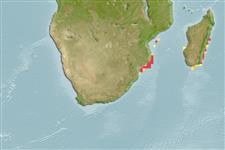Elasmobranchii (haaien en roggen) (sharks and rays) >
Carcharhiniformes (Ground sharks) >
Scyliorhinidae (Cat sharks) > Scyliorhininae
Etymology: Cephaloscyllium: cephalus, from kephale (Gr.), head, referring to its very broad and depressed head; skylion, Greek for dogfish or small shark (See ETYFish); sufflans: Latin for puffing, referring to its inflatable stomach (See ETYFish).
More on author: Regan.
Environment: milieu / climate zone / depth range / distribution range
Ecologie
marien demersaal; diepte 40 - 600 m (Ref. 5578). Tropical; 19°S - 28°S
Western Indian Ocean: Mozambique and Natal, South Africa (Ref. 244). Records from the Gulf of Aden are doubtful. Nominal records from Viet Nam were based on an undescribed species often called Cephaloscyllium umbratile which was not even that species.
Grootte / Gewicht / Leeftijd
Maturity: Lm ? range ? - 82 cm
Max length : 110 cm TL mannelijk / geslacht onbekend; (Ref. 5578)
Korte beschrijving
Determinatiesleutels | Morfologie | Morfometrie
Dorsale stekels (totaal) : 0; Anale stekels: 0. A comparatively large, stout catshark with a broad, rounded snout and no labial furrows; 2nd dorsal much smaller than 1st (Ref. 5578). Pale grey-brown, paler below; juveniles with about 6 slightly darker saddles on the dorsal side which fade and become unmarked in adults (Ref. 5510).
Found on the continental shelf and upper slope, preferring areas with sand and mud bottoms (Ref. 5578). Feeds on benthic animals, mainly crustaceans and cephalopods, but also bony fishes, and other elasmobranches (Ref. 244). Oviparous (Ref. 50449). Can expand with air when disturbed (Ref. 244).
Oviparous, laying one egg-case per oviduct (Ref. 244). Embryos feed solely on yolk (Ref. 50449).
Compagno, L.J.V., 1984. FAO Species Catalogue. Vol. 4. Sharks of the world. An annotated and illustrated catalogue of shark species known to date. Part 2 - Carcharhiniformes. FAO Fish. Synop. 125(4/2):251-655. Rome: FAO. (Ref. 244)
Status op de Rode Lijst van het IUCN (Ref. 130435: Version 2024-1)
Gevaar voor de mens
Harmless
Gebruik door de mens
Visserij: van geen belang
Tools
Speciale rapporten
Download XML
Internetbronnen
Estimates based on models
Preferred temperature (Ref.
123201): 14.4 - 19.2, mean 15.9 °C (based on 17 cells).
Fylogenetische diversiteitsindex (Ref.
82804): PD
50 = 0.5000 [Uniqueness, from 0.5 = low to 2.0 = high].
Bayesian length-weight: a=0.00263 (0.00138 - 0.00502), b=3.21 (3.04 - 3.38), in cm total length, based on LWR estimates for this (Sub)family-body shape (Ref.
93245).
Trofisch niveau (Ref.
69278): 4.2 ±0.61 se; based on food items.
Weerstandsvermogen (Ref.
120179): laag, minimale populatieverdubbelingstijd 4,5-14 jaar (Fec assumed to be <100).
Fishing Vulnerability (Ref.
59153): High to very high vulnerability (66 of 100).
